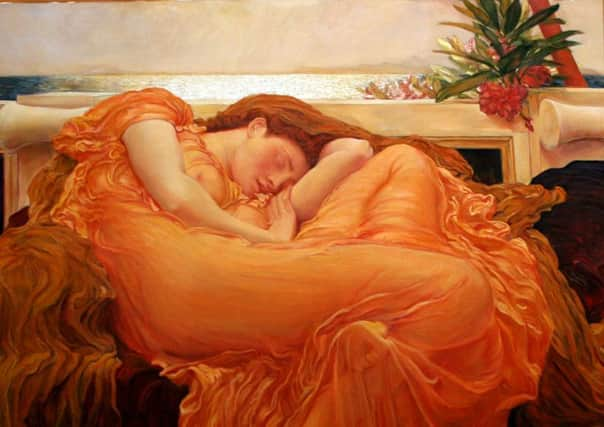Discovered: famous artist’s lost drawing from his masterpiece


Scarborough-born Frederic Leighton’s painting, showing a woman in an orange dress sleeping, is one of the most popular from the era, with prints of the work adorning many living room walls.
Experts knew that the British artist had made a pencil and chalk head study of the painting, but had no idea of its whereabouts since it was last reproduced in an art magazine in 1895, the same year in which Flaming June was painted.
Advertisement
Hide AdAdvertisement
Hide AdIt has been found hanging behind an open bedroom door at West Horsley Place, the “time capsule” Surrey mansion of the late Mary, Duchess of Roxburghe, and will be going under the hammer at Sotheby’s this summer.
The Duchess is thought to have inherited the sketch, described as “one of the most important surviving drawings” relating to Flaming June, from her grandfather, who knew Lord Leighton.
Sotheby’s Victorian art specialist Simon Toll said: “I immediately realised what it was ... It is a thrilling find, one of the most heart-stopping moments of my career.”
Being the only known head study for the painting, it provides a “missing link in the preparatory work Leighton undertook for the oil”.
Advertisement
Hide AdAdvertisement
Hide Ad“The head study was the only bit of the preparatory work that was lost,” Mr Toll said.
The specialist discovered the sketch seven years ago during an insurance valuation at West Horsley Place but has not been able to reveal his find because of owner confidentiality until now.
He said that Flaming June stood out from much Victorian art.
“It’s an incredible picture, probably one of the most famous images from the 19th century.
Advertisement
Hide AdAdvertisement
Hide Ad“People think of Victorian art as a little bit schmaltzy and pretty. But this is not a particularly sentimental picture. It is such a romantic image, it’s almost abstract, there’s no narrative, it’s really about colour, pose and composition.”
Despite now being internationally famous and worth tens of millions of pounds, Victorian art fell out of fashion after Lord Leighton’s death and Flaming June disappeared for 30 years.
It reappeared in 1963 on a market trader’s stall in Chelsea and was sold to a London-based Polish frame maker for just £50.
It was later “virtually given away” to the then governor of Puerto Rico and is now on display at a museum there, and dubbed the Mona Lisa of the Southern Hemisphere.
Advertisement
Hide AdAdvertisement
Hide AdLord Leighton was a celebrated figure when he died a year after completing Flaming June, and the painting was acclaimed when he displayed it at the Royal Academy.
Queen Victoria sent a wreath from Buckingham Palace when the artist was buried at St Paul’s Cathedral.
Leighton was born in Scarborough to a family in the import and export business. He was educated at University College School, London. He then received his artistic training on the European continent, first from Eduard von Steinle and then from Giovanni Costa. When he was 24 he was in Florence; he studied at the Accademia di Belle Arti, and painted the procession of the Cimabue Madonna through the Borgo Allegri. From 1855 to 1859 he lived in Paris.
The drawing will be auctioned in a sale of Victorian, Pre-Raphaelite and British Impressionist Art at Sotheby’s in London on July 15.
Contents from West Horsley Place will be sold at Sotheby’s in London on May 27 and 28. Flaming June will be exhibited in New York for the first time, at the Frick Collection, this summer.